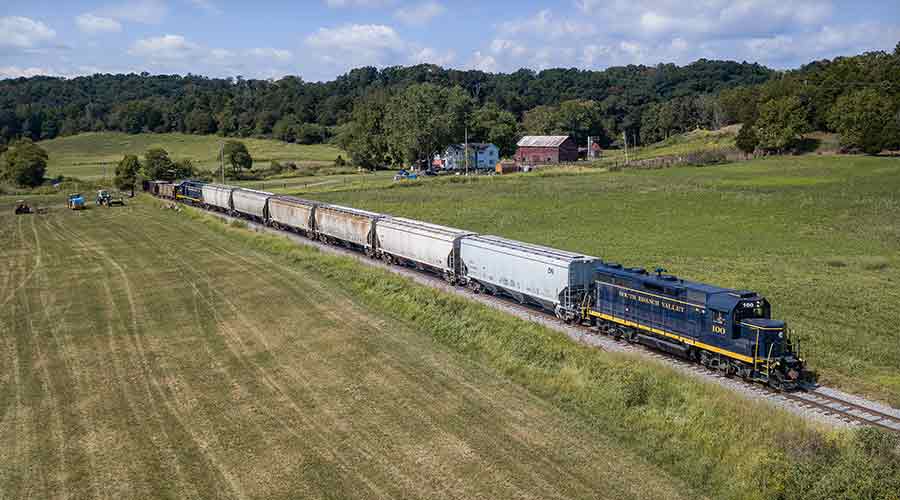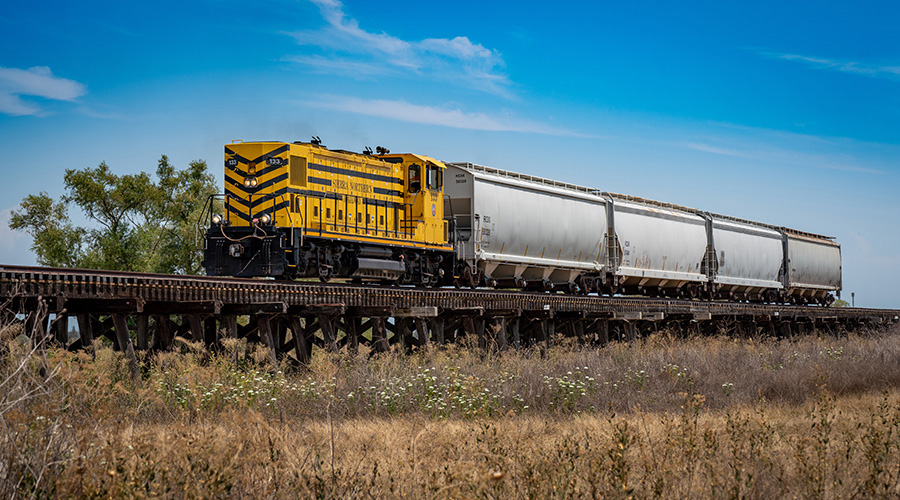OmniTRAX preps for growth on its newest short line: West Virginia's South Branch Valley
12/13/2023
By Julie Sneider, Senior Editor
Effective Dec. 1, OmniTRAX Inc. took over operational management of the South Branch Valley Railroad (SBVR) under a 40-year lease with the West Virginia Department of Transportation.
A 52.4-mile line operating between Petersburg and Green Spring, West Virginia, the SBVR is a former branch of the Baltimore & Ohio Railroad Co. that provides freight service to West Virginia’s eastern panhandle. The short line serves the Grant County Industrial Park in Petersburg, Moorefield Industrial Park, and Hampshire County Industrial Park in Romney. The SBVR connects to CSX in Green Spring.
The SBVR is the second railroad that OmniTRAX runs in West Virginia: In 2019, it acquired the Winchester & Western Railroad (WW), which has attracted $2.6 billion of direct investment along the line and created 6,000 direct and indirect jobs, according to OmniTRAX officials. Another former part of the Baltimore & Ohio, the WW runs from Hagerstown to Winchester, Virginia, through West Virginia. Since the acquisition, WW and OmniTRAX officials have worked with state officials and local economic development commissions to attract new business from such companies as Commercial Metals Co. (CMC), which in July began construction on a new plant in Martinsburg, West Virginia; the Clorox Co., which last year opened a new cat litter manufacturing plant in Martinsburg; and Procter & Gamble, which runs a 2.5-million-square-foot mega factory in Berkeley County.
It was dialogue with West Virginia state and economic development officials about further developing the WW and its customer base that OmniTRAX became interested in potentially operating the SBVR, says Stacey Posey, vice president of operations for OmniTRAX’s central region.
 As of Dec. 1, the South Branch Valley Railroad in West Virginia became the 26th short line operated or owned by OmniTRAX. OmniTRAX Inc.
As of Dec. 1, the South Branch Valley Railroad in West Virginia became the 26th short line operated or owned by OmniTRAX. OmniTRAX Inc. “Since the WW acquisition, we’ve been able to formulate a very good partnership with the state of West Virginia,” Posey says. “We just kind of said to the state, ‘We think we can be a good partner and help you develop this [SBVR] property.’ We pitched what we thought is the potential for bringing in jobs just like we’ve helped do in Martinsburg.”
Those conversations evolved, eventually resulting in the lease agreement to manage the SBVR’s operations. The deal was announced this summer. Per the agreement, OmniTRAX will have to meet certain operating performance metrics, including making sure the Potomac Eagle, the SBVR’s excursion train that operates during the summer and autumn season, runs on time. It’s the first time that OmniTRAX will be responsible for dispatching passenger/tourist trains. It’s anticipated the Potomac Eagle will serve about 44,000 passengers this year, Posey says.
In negotiating the SBVR pact, the state also had two “asks” of OmniTRAX: “They asked us to protect the employees that worked for the SBVR and to protect the tourist industry there,” says Posey. “We were able to bring on the 14 train-and-engine employees; they’re now on our payroll. The maintenance-of-way [employees] will stay with the [state] DOT. And the tourist train is protected in the agreement.”
The SBVR also comes with five locomotives, 34 bridges and other infrastructure to maintain, he says. Under the lease agreement, OmniTRAX and the state will split 50-50 the cost of maintaining the railroad. As carload traffic increases on the line, OmniTRAX will assume a larger portion of maintenance costs.
“Once it reaches the agreed upon threshold, we’ll have 100% of the railroad’s maintenance,” Posey says.
Currently, the SBVR logs about 1,600 carloads annually. OmniTRAX’s growth model calls for 10% annual growth “and I would hope we could beat that,” Posey says.
The first infrastructure focus will be to take a close look at the state of the bridges, then develop a plan for what’s needed as volume grows. Also in the works is a plan to add a sixth, more powerful locomotive that can pull tonnage more efficiently, Posey says.
To help fund some of those future infrastructure projects, Posey sees the potential for the state and SBVR to jointly apply for federal funding through the Federal Railroad Administration’s Consolidated Rail Infrastructure and Safety Improvements program.
 A 52.4-mile line operating between Petersburg and Green Spring, West Virginia, the SBVR is a former branch of the Baltimore & Ohio Railroad Co. that provides freight service to West Virginia’s eastern panhandle. OmniTRAX Inc.
A 52.4-mile line operating between Petersburg and Green Spring, West Virginia, the SBVR is a former branch of the Baltimore & Ohio Railroad Co. that provides freight service to West Virginia’s eastern panhandle. OmniTRAX Inc. “Although we don't yet have the projects identified, I can say it would be for the typical things — ties, rail, bridges,” Posey says.
Plans for volume growth
To prep for growth, OmniTRAX added four employees to the SBVR, including an assistant general manager. All are local hires, he says. The railroad’s GM is Doug Long, who fills the same role at the WW. The SBVR’s largest customer is chicken-producer Pilgrim’s Pride Corp., which operates a poultry feed mill in Moorefield, West Virginia. Other customers include Greer Lime, which ships limestone products; and Allegheny Wood, which ships flooring materials.
Posey anticipates growing existing customers’ business on the line, as well as attracting new customers and companies interested in accessing freight-rail service.
“We've already reached out to Pilgrim’s Pride, as well as their parent company JBS, to talk about what they need, what they want, what do they see coming and how we can put an operating plan around it,” says Posey.
“We’ve also reached out to CSX — and their response has been fantastic — about getting additional product there. So, the first steps are making sure we get the service [Pilgrim’s Pride] needs and then work with them to grow the service as they need it.”
Fitting the OmniTRAX model
The SBVR is the 26th short line or regional operated or owned by OmniTRAX. As more industry looks to locate in West Virginia and its eastern panhandle, the SBVR and the WW will be part of the package “when we show property in this area,” Posey says.
As an affiliate of the Broe Real Estate Group, OmniTRAX can assist companies looking for rail-served sites via its Rail-Ready Sites program.
“When we speak to people, we speak to the fact that we can provide almost turn-key solutions for industry, for manufacturing, for warehousing, for logistics, for land purchase,” he says.
That’s where SBVR fits the OmniTRAX model of being part of the “full package” that the holding company can offer to potential customers.
To fully integrate SBVR into the OmniTRAX family, Posey and company officials have been networking with the locals in the cities of Romney, Moorefield and Petersburg, as well as the corresponding counties.
“Our goal, task and challenge in the next few months will be to learn the industry, learn the SBVR, learn the people, learn their culture and listen, listen, listen,” he says. “Listen and lead from the ballast, I like to say.”
That getting-to-know-you process is an important part of short-line railroading, Posey believes.
“I think the challenge for short lines — and it’s also part of the draw — is the direct impact that you have with the customer,” he says. “I mean, you truly are their first-and-last mile. You get to know these people. You're very ingrained in their communities. You see the impact that you can have on their companies, especially the smaller companies.”


